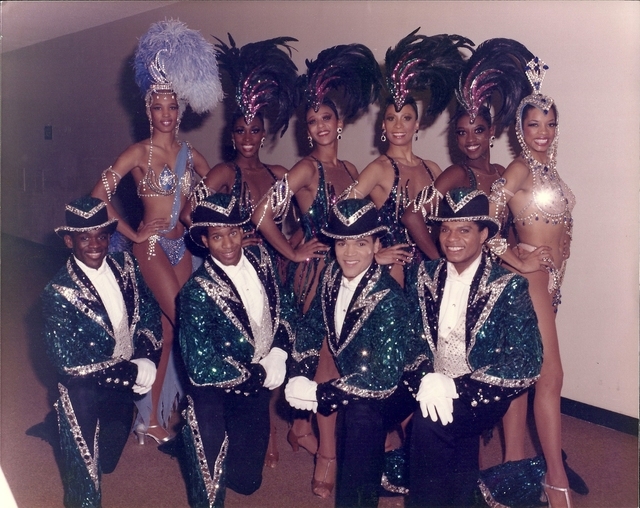Photography exhibit tells tales of ebony guys, dolls
Looking at her collection of photos and seeing the costumes dripping with jewels, the dancers glistening and the stage in all its glory, LaVerne Ligon can’t help but be flooded with memories.
“I wish I looked like that now,” Ligon said, laughing.
She was one of the first African-American performers who danced in the first house line of black dancers on the Strip at Bally’s — “Hallelujah Hollywood.”
Though that show is gone, it is not forgotten.
“Reflections of the Ebony Guys, Dolls & Techs,” a photo exhibit chronicling black dancers and technicians, is scheduled to be featured through the end of March at the Green Valley Library, 2797 N. Green Valley Parkway.
Kevin Scanlon, head of adult services at the Green Valley Library, said this is an extension of the Henderson Libraries series “Created Equal: America’s Civil Rights Struggle.” The series featured documentaries and seminars from African-Americans in the community.
After one of the panel discussions with Ligon, Scanlon decided the most natural progression was to include photos she had from her time as a dancer.
“I think it’s good to give more local history,” Scanlon said. “This is a great way to talk about entertainment history.”
Scanlon added it was a creative way to talk about the process of integration in Strip shows.
Ligon’s journey to the stage began in Maryland, where she grew up and learned to dance.
“I was shy and didn’t talk much,” she said. “I always loved the arts. There was a girl in my neighborhood who was doing ballet. I started going to her (ballet) school.”
She kept progressing with ballet and went on to study at ballet schools in New York.
Ligon eventually landed a role in the African-American version of “Hello, Dolly!”
In 1973, she got a call from a studio looking to hire dancers for a show in Las Vegas.
Ligon auditioned for the show. However, when she was told it would be topless, she protested.
“They told me I was living in the dark ages,” she said. “But I was a dancer. I was classically trained. I knew jazz and African dance.”
Ligon won her fight and moved to Las Vegas.
“Hallelujah Hollywood” opened in 1974.
The production didn’t just feature an all-black line of dancers, it also had black technicians.
For the most part, Ligon said there wasn’t any animosity toward black showgirls at the time.
However, she did encounter a few patrons who treated the girls with disrespect.
“I was on my coffee break, and one guy accused me of being a call girl,” she said.
One time, a group of men in the front row of the show was harassing the girls.
“So we made a plan,” Ligon said.
The girls, not missing a beat of the routine, went into the audience next to the patrons.
“We did a swift turn and — bam — hit them upside the head,” she said.
The tale of the head-slamming custom was enough to deter further harassment.
Ligon said the shows and the ability of the dancers helped to pave the way for more integrated shows.
In 1981, Ligon began working at “Jubilee!”
After the MGM fire, she took a brief break to work as a dancer in a show at the Stardust.
“But once ‘Jubilee!’ opened back up, all the girls went back over,” she said.
She was there until an injury ended her career as a dancer.
Ligon now helps other aspiring dancers in achieving their dreams. She had her own dance studio for a while.
“I miss it, but I think I’ve aged gracefully,” she said. “Now I am fulfilled to see youth develop.”
Ligon recently talked at the Green Valley Library about her experiences as one of the first African-American showgirls. She connected with Scanlon at the library.
To kick off the exhibit, the library showed a documentary by the same name, “Reflections of the Ebony Guys, Dolls & Techs,” which was made in 2012 and features firsthand accounts from Ligon and several other dancers.
After the exhibit’s time at the Green Valley Library ends, Ligon hopes to show the photos in other places around town.
“I even want to send it to Reno,” she said.
Contact Henderson/Anthem View reporter Michael Lyle at mlyle@viewnews.com or 702-387-5201. Follow on Twitter @MjLyle.





























